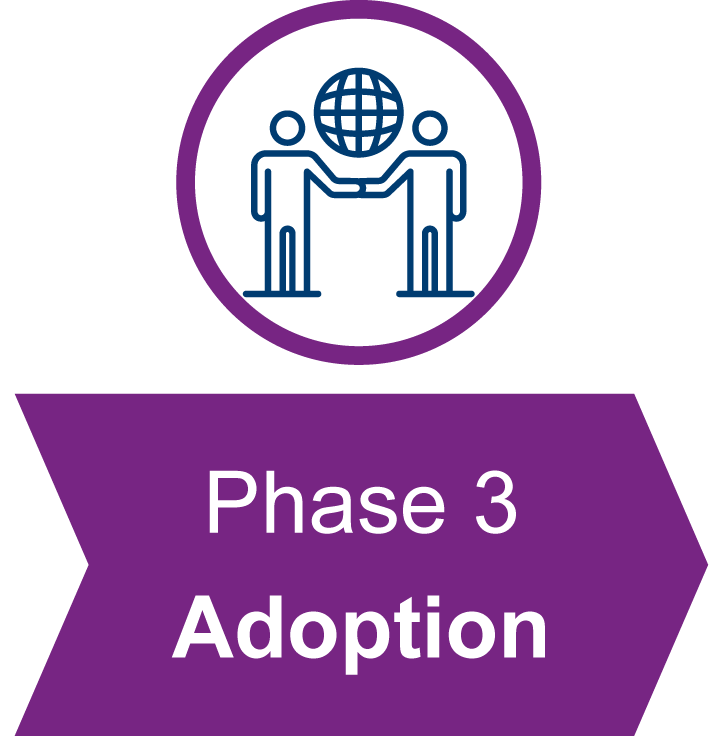Consumer
Example: Business Application Team
Cloud Consumers are individuals or organizations that purchase and utilize cloud products
and/or services and maintain relationships with the Cloud Ecosystem. An example of a GSA cloud consumer is a
business looking to modernize their applications by moving to the Cloud. As depicted below, the Cloud Smart
Journey is a set of processes that enable stakeholder collaboration and engagement to help the cloud
consumer identify, build, and implement the optimal cloud adoption strategy while at the same time aligning
with GSA's modernization goals and Ecosystem standards.
Once the team's sponsor presents their project to the CAWG for approval, the modernization team lead
will submit a ServiceNow Service Request to officially connect with the Cloud Advisory Team and begin
the Cloud Smart Journey. The discovery and collaboration that occurs in this phase through the Lean
Intake Questionnaire and Requirements template allows Cloud Advisory to understand the needs of the
project team and assess their risk level and readiness in order to develop and facilitate the optimal
solution.
For the Advisory Phase, the team will continue to partner with Cloud Advisory in reviewing and iterating
on the submitted project requirements. Discovery continues as Cloud Advisory completes a stakeholder
analysis and overall assessment of requirements, compliance, rationalization, and other critical areas
prior to making their cloud recommendation. It is at this phase of the journey where the Cloud Product
Teams will be consulted on items including security, architecture, etc. This approach helps to minimize
risks and enable greater efficiency as the project gets underway.
During Cloud Enablement, the Cloud Advisory Team prepares a transformation strategy and action plan
based on the recommendation developed in the Advisory Phase. The team will also collaborate to develop a
cost estimate, and a notional schedule. These artifacts will be shared, discussed, and finalized with
the Project Sponsors. In preparation for adoption, the Advisory and Cloud Enablement Triage (CETT) Teams
will develop an onboarding checklist based on the selected cloud products and services. This checklist
will be reviewed with the team and used to ensure a smooth transition.

This phase requires significant collaboration and communication across stakeholders working in parallel
to reach deployment. CETT will initiate this phase with a kick-off meeting and immediately institute a
set of support structures that will remain in place throughout this phase (Touchpoints and Google
ChatOps will provide regular opportunities to collaborate and work through issues). The Product teams
will coordinate with the Modernization Project Team on reference architecture, ecosystem roadmap and
backlog input, and collaborate on environment spec and buildout. Modernization Project Teams can submit
tickets through JSM to work through specific issues and needs during the process. The FCS Security Team
will assist with the completion of the Systems Security Plan and keep the application team informed on
status as the process progresses towards the ATO. Working closely with the stakeholders and following
the onboarding checklist is critical for driving towards the scheduled deployment.
The optimization phase consists of both O&M and Future Improvement efforts. While CETT and the Product
and Compliance Teams ensure the applications are running smoothly and remain ready to address issues as
they arise, the Cloud Advisory Team remains connected to project/application status for reporting
purposes. In addition, Cloud Advisory collaborates with the Modernization Project Teams annually from a
planning and modernization perspective - focusing on the identification of improvement opportunities.
Producer
Example: GSA Security Team
Cloud Producers are those within GSA IT who provide or respond to consumer needs for a
specific product and/or service. An example of a GSA cloud producer is the Security Team that may have a
need or requirement to update or implement new Cybersecurity features that impact cloud consumers. In
this example, GSA Security will navigate through the Cloud Smart Journey which will ensure an optimal
solution for modernizing their technology while minimizing impact and maximizing value for cloud
consumers.
Once the team's sponsor has brought their initiative to the CAWG for review and prioritization, the team
will submit a ServiceNow Service Request. The Cloud Advisory team will then orchestrate an initial
discussion with relevant stakeholders to confirm the documentation needed for discovery and for
assessing cloud readiness and risks.
The partnership with the Advisory Team continues as requirements are identified and confirmed with GSA
Security and other stakeholders as needed. At this point, the Advisory Team can more accurately assess
the value proposition, risks, and overall impact to the Cloud Ecosystem and Modernization Project teams
to inform the recommendation. Cloud Advisory will ensure GSA Security understands the Cloud Smart
Journey process and what will be required to reach optimization.
During Cloud Enablement, the Cloud Advisory Team will prepare a transformation strategy and action plan
based on the recommendation developed in the Advisory Phase. The team will also collaborate to develop a
cost estimate, and a notional schedule. These artifacts will be shared, discussed, and finalized with
the Project Sponsors and all relevant stakeholders. In preparation for adoption, the Advisory and Cloud
Enablement Triage Teams (CETT) will develop an onboarding checklist based on the selected cloud products
and services. This checklist will be reviewed with the team and used to ensure a smooth transition.

This phase requires significant collaboration and communication across stakeholders working in parallel
to reach deployment. CETT will initiate this phase with a kick-off meeting and immediately institute a
set of support structures that will remain in place throughout this phase (Touchpoints and Google
ChatOps will provide regular opportunities to collaborate and work through issues). The Product teams
will coordinate with the Project Modernization Team on reference architecture, ecosystem roadmap and
backlog input, and collaborate on environment spec and buildout. Project Modernization Teams can submit
tickets through JSM to work through specific issues and needs during the process. The FCS Security Team
will assist with the completion of the Systems Security Plan and keep the Project Modernization Team
informed on status as the process progresses towards the ATO. Working closely with the stakeholders and
following the onboarding checklist is critical for driving towards the scheduled deployment.
The optimization phase consists of both O&M and Future Improvement efforts. While CETT and the Product
and Compliance Teams ensure the applications are running smoothly and remain ready to address issues as
they arise, the Cloud Advisory Team remains connected to project status for reporting purposes. In
addition, Cloud Advisory collaborates with the Project Modernization Teams annually from a planning and
modernization perspective - focusing on the identification of improvement opportunities.



